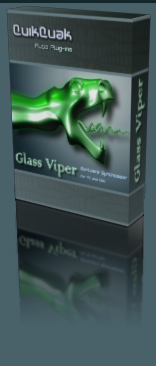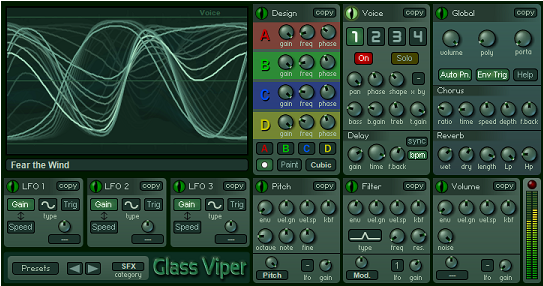

Synthesizer plug-in
* Unique and organic synthesis.
* Wave shaping with 16 LFO's.
* Continuously changing waveform.
* Easy to edit, basic interface.
* 4 Voices per instrument.
* 12 LFO Envelopes with speed and
gain slopes.
* 4 Delay lines per instrument.
* Reverb and chorus effects.
* Comprehensive copy and
paste features.
* Wave shaping with 16 LFO's.
* Continuously changing waveform.
* Easy to edit, basic interface.
* 4 Voices per instrument.
* 12 LFO Envelopes with speed and
gain slopes.
* 4 Delay lines per instrument.
* Reverb and chorus effects.
* Comprehensive copy and
paste features.
click picture for full size
What is it?
Glass Viper is a synthesizer with unique waveform shaping, that has a deep and natural sense of movement. Going beyond analogue simulation, into a truly organic sound, from simple old synths to grungy filthy basses, or delicate pianos to strange unnatural film effects.
Instead of taking a sample or oscillator and applying just filters and FX techniques, Glass Viper bends the actual shape of its waveforms through a series of moving control points. Up to four of these swirling and changing sounds can be layered together to create a huge range of instruments. Glass Viper allows you to really shake things up with a deep, natural sense of movement.
Instead of taking a sample or oscillator and applying just filters and FX techniques, Glass Viper bends the actual shape of its waveforms through a series of moving control points. Up to four of these swirling and changing sounds can be layered together to create a huge range of instruments. Glass Viper allows you to really shake things up with a deep, natural sense of movement.
Philosophy

From the start, Glass Viper's goal was to make sound creation visual, and distance itself from mathematics. Making something with a unique sound was also a priority, and in a world full of synthesizers, this had to mean a fundamental difference. Without the complexity of many changeable modules, Glass Viper encourages play and experimentation. Most of the presets available were born from experimentation, rather than setting out to make a particular sound.
More details
Glass Viper's moving waveform is the fundamental to its sound. When a note is held, the sound can move in a natural and pleasing way, without repetition.
Like RaySpace, the visual aspect is also a major part of Glass Viper, guiding the user to a more experimental and less mathematical route to sound creation. The main display will change depending on which panel you are selecting. On the Voice panel the four waveforms of the currently playing note are directly displayed. On the Global panel the actual whole output waveform is plotted. And on the Waveshaper panel, you can edit the waveforms in real-time so you can really get the feel of the sound creation process. There is an extensive copy and paste algorithm, which enables you to copy either each panel, voice or whole (4 voices) instruments - this speeds up the sound creation process enormously, and also allows the user to use parts of different presets to make new ones.
Like RaySpace, the visual aspect is also a major part of Glass Viper, guiding the user to a more experimental and less mathematical route to sound creation. The main display will change depending on which panel you are selecting. On the Voice panel the four waveforms of the currently playing note are directly displayed. On the Global panel the actual whole output waveform is plotted. And on the Waveshaper panel, you can edit the waveforms in real-time so you can really get the feel of the sound creation process. There is an extensive copy and paste algorithm, which enables you to copy either each panel, voice or whole (4 voices) instruments - this speeds up the sound creation process enormously, and also allows the user to use parts of different presets to make new ones.
General features
* 4 editable waveforms, that can move independently during play.
* 16 independant LFOs for waveform movement.
* 8 bass and treble boost EQs.
* 4 unique waveshapers, with distorted top settings.
* Multiple copy and paste options for quick editing and layering.
* 4 delay lines with BPM syncronisation option.
* 12 LFO's with independant speed and gain envelopes.
* Multiple ring modulation.
* 4 volume envelopes, with velocity sensitivity for amount and speed.
* 4 filter envelopes, using over sampled biquads with up to 24db slope per octave.
* 4 pitch envelopes.
* Stereo chorus with feedback.
* Fusion Field reverb with simple EQ.
* 256 categorised factory presets.
* 16 independant LFOs for waveform movement.
* 8 bass and treble boost EQs.
* 4 unique waveshapers, with distorted top settings.
* Multiple copy and paste options for quick editing and layering.
* 4 delay lines with BPM syncronisation option.
* 12 LFO's with independant speed and gain envelopes.
* Multiple ring modulation.
* 4 volume envelopes, with velocity sensitivity for amount and speed.
* 4 filter envelopes, using over sampled biquads with up to 24db slope per octave.
* 4 pitch envelopes.
* Stereo chorus with feedback.
* Fusion Field reverb with simple EQ.
* 256 categorised factory presets.
Luftrum has designed 64 presets for Glass Viper
Available to purchase on the Luftrum site.
Includes many lush pads, textures and synths.
Available to purchase on the Luftrum site.
Includes many lush pads, textures and synths.





